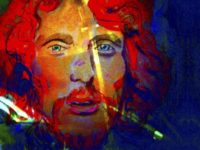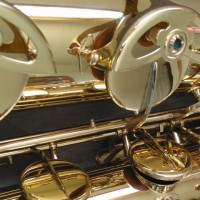Terry Edwards has an infectious grin, a gentle manner and is well known as a sax player. He plays solos with a free-form twist and adds innovative lines to his musical work. I have seen him play a couple of times, and he has a quiet but influential presence on stage.
Terry’s musical interest began by a chance quirk of fate. He was born in Hornchurch, Essex and at 5 years old he broke his leg. With his leg in plaster, he couldn’t run after a football for a few weeks, so Terry Edwards took an interest in his mum’s piano. This interest lasted just a couple of years before fading but the seeds were sown, and years later when Terry went to senior school he took up piano again and also began to learn the trumpet.
He says, “I went down the ‘classical’ route and passed exams in both those instruments plus musical theory. In the meantime, what I really wanted to play was the guitar — in the hope I’d become a pop star of course. So, I was in the school and local youth orchestras whilst at the same time learning Beatles, Stones and Led Zeppelin tunes amongst others — ’til punk came along! In my mid-teens, I thought I should learn a bit about jazz. My father had already bought me a couple of Louis Armstrong LPs but, whenever I’d seen him on TV, Louis was always singing rather than playing and I had no idea of his contribution to jazz until much later. So, I picked up a budget price Best of Earl Bostic LP from WH Smith. ‘Flamingo’ and ‘Harlem Nocturne’ quickly became my favorites. Then, for my 18th birthday, I was given an alto saxophone.”
Terry Edwards came to play the sax with an understanding of music already, but did not take the conventional route. He explains, “Although I knew how to read music, understood harmony and had a good ear I was self-taught in many respects. I never learned people’s solos note-for-note from listening to records. I didn’t know you were ‘meant’ to. I thought you should play a different solo every time, so I came to that much later on. Inspirational sax players were Davey Payne from Ian Dury and the Blockheads (another Bostic fan, unsurprisingly), some of the Bowie stuff from David Live and Pinups and John Lurie from the Lounge Lizards. Regarding the guitar, I listened to a lot of things and tried to play both lead and rhythm parts simultaneously — which is the root of a lot of my guitar parts on Higsons records.”
Terry was a founder member of the Higsons, a group formed at the University of East Anglia in 1980 with members Charlie Higson (vocals), Terry Edwards (guitar/saxophone/trumpet), Stuart McGeachin (guitar), Simon Charterton (drums), Colin Williams (bass) and David Cummings on guitar. They were signed to Two Tone records and released a single “I Don’t Want to Live with Monkeys” in 1981. They had some UK chart success before disbanding in 1986.
“There was a hefty New York influence on my playing from 1982 onwards,” Terry Edwards said. “I discovered sax player James Chance, guitarist and vocalist James Blood Ulmer and Defunkt — largely because the Higsons supported all three bands around that time! I delved deeper into jazz and found Thelonious Monk, [Charles] Mingus, Ornette Coleman and Roland Kirk too. I won’t pretend that I fell in love with that music immediately but, once I did, I stayed in love with it. Guitarists Robert Quine (Dimstar, the Voidoids) and Marc Ribot (Lounge Lizards and also worked with Tom Waits, John Zorn amongst many others) were a revelation, too. I lapped all of this up while still having a healthy interest in Elvis Costello, Julian Cope and a galaxy of post-punk stars.”
He adds, “I came to dabble in some Hammond organ playing. I am not a virtuoso but can find my way round the drawbars quite niftily, and my most recent acquisition is a flute which I love playing despite struggling with the technique.“
Terry’s early performances were with the school orchestra and then playing trumpet in Havering Youth Orchestra, performing in Essex but he had his first London concert at the Albert Hall. “The Havering Youth Orchestra won a competition to play at an event called Youth Makes Music and we performed Finlandia by Sibelius and a second piece there,” Terry Edwards said. “I’ve since trod the boards there with PJ Harvey, Duke Spirit, Sam Moore and Robyn Hitchcock and John Paul Jones. The first London show by the Higsons was at the 100 Club, supporting Wah! Heat. The Frantic Elevators were on the bill, too.”
Terry’s groups also included New York New York, Butterfield 8. Guest musicians included jazz musicians such as vibraphone player Roger Beaujolais, trumpeter John Eacott, trombone player (with Madness) Mike Kearsey, percussionist Dave Bryant and the late saxophone player Jerry Underwood of Spirit, Terry Edwards and the Scapegoats and the Near Jazz Experience (with Simon Chatterton from the Higsons and Madness’ bass player Mark Bedford). Terry has also been part of significant others including Gallon Drunk, Tindersticks, PJ Harvey, Nick Cave and the Bad Seeds, Madness, the Blockheads, Jerry Dammers’ Spatial A.K.A.
As well as the range of bands and projects, Terry has also been involved in large productions including The Black Rider (Tom Waits / Robert Wilson / William Burroughs) with performances in London, San Francisco, Sydney and Los Angeles; Big Star Third as conductor/woodwind player at the Barbican, London and Blow The Bloody Doors Off. Terry Edwards was also musical director of performances of music from Michael Caine movies at the Barbican Centre in London 2014 and Adelaide 2015.
Terry Edwards listens to a lot of music. “I listen to stuff I have to learn as a session musician,” he said. “I’m a big fan of the radio, though, as you hear a lot of new music, not just your own record collection. Gideon Coe, Marc Riley and a whole slew of 6Music presenters and Late Junction on Radio Three are my mainstays. Roland Kirk and Harold McNair are on my playlist a lot at the moment. There are old favorites I return to such as John Cale, Led Zeppelin, John Zorn and Bach’s St. Matthew Passion. Jazz food for the soul is always Thelonious Monk and Ornette Coleman, alongside Jimmy Smith and Charles Mingus. I spent many an hour in the ‘80s with Tom Waits and the Jesus and Mary Chain on constant rotation. Despite that, I still don’t tire of them.”
When Terry Edwards plays, he is aware of musicians on stage with him and the reactions of the audience. “I’ve always had quite an affinity with drummers — which is a good thing, as I have my back to them almost all the time so playing becomes intuitive,” he said. “Ian White, drummer from the Scapegoats and Gallon Drunk, is a great case in point. We don’t make much eye-contact but we lock together naturally, particularly in free-jazz sessions. The relationship between audience and musicians depends a lot on what’s coming offstage. If we’re having fun, the audience knows it and picks up on it. A good example is the tour I’m on at the moment — Holy Holy with Glenn Gregory, Tony Visconti and Woody Woodmansey, a 10-piece band. Everyone we meet after the show has had a great time, and comments on how much fun we’re having onstage. It’s contagious.”
Edwards has just finished a stint at the Edinburgh Festival, and of this and future projects he says: “At Edinburgh, I was doing three shows a night for three weeks: ‘Beyond Harlem Nocturne’ and ‘Old, New, Borrowed and Blue’ set with Tindersticks’ lead guitarist Neil Fraser, looking at our back catalogs alongside music we’ve created especially for the festival. ‘Happy Hour’ and ‘What the Funk?’ are two shows with Pete Saunders (formerly of Dexys Midnight Runners) in his blues and burlesque guise, which were fun. I am looking forward to touring with PJ Harvey next year, too. Something interesting always turns up — and it’s usually quite loud.”
Terry Edwards still has an eclectic taste: I recently bumped into him at a gig at Café Oto in London where Terry Day, Alan Wilkinson, Nick Charles, Davey Payne and Pat Thomas were playing some very decent free jazz.
“There are a lot of preconceptions when it comes to certain types of music and jazz is a particular case in point,” Terry Edwards adds. “Often, folks are pointed towards some jazz classics — Kind of Blue and so on — and it’s easy to write off the whole genre, if they don’t like those albums on first listen. However, once you’re in a live setting and you just play without pigeon-holing, then it’s easier to get what’s loosely defined as jazz. It’s all down to taste, and people, young and old, have that. Once you get away from the rules, you can start having fun. For the record, I much prefer electric Miles to the traditional acoustic line-ups. The only way to get jazz to younger audiences is to stop treating the music as being a museum and to not try to ‘educate’ people about it. Inquisitive listeners will always, always dig out the good stuff.”
One thing is certain: Terry Edwards, with his gentle stage presence and musical talent, will provide good stuff for those inquisitive listeners for a long time to come.
- Wabi Sabi – ‘The Love Insane’ (2024) - March 24, 2024
- James McGowan Ensemble – ‘Reaching In’ (2023) - December 10, 2023
- Defne Sahin – ‘Hope’ (2023) - November 19, 2023




